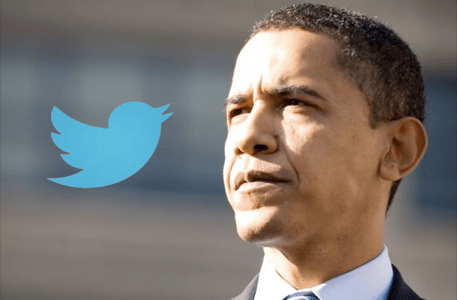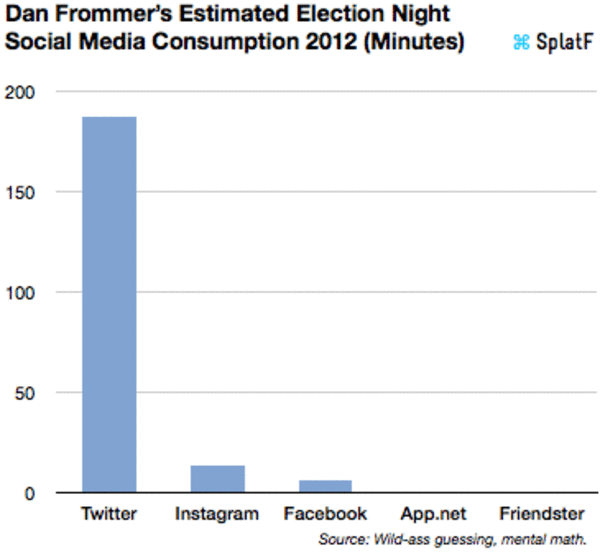
In case you missed it, the United States elected a president yesterday. I try to stay away from politics — it’s only fun in Chicago, anyway — but last night, I anxiously tuned in.
Election night television, it seems, hasn’t changed much in the past four years — the same guys in the same bad suits, pointing at maps, reading wire updates, and trying not to screw up. The biggest difference, I noticed, is how the main tool I really used was Twitter.
To the daily Twitter user, this, by now, seems obvious; a cliché barely worth repeating. But step back for a second and think back to an era — not long ago — when this didn’t exist. When the only analysis and opinion you had instant access to was from your friends in the room and the mouth-breathers the TV producers had picked for you.

Then look over at Twitter, where the room is bursting with fresh news, links, photos from everywhere, alerts that Karl Rove is melting down or that Diane Sawyer seems wasted, jokes coming so fast that you can barely keep up. (Many of them even funny.) You control the content, the sources, the volume, the pace, and your drink. Sometimes, it’s wrong, but it’s quickly corrected, and you should be more skeptical anyway. And if you want, you can participate. You’re not just watching.
Over the past ten days, with Hurricane Sandy and now the election, I’ve spent an unusual amount of time at home, sitting on my couch. The TV was often on, and sometimes useful: Some stuff is still better and faster observed in live video format. The emotion of an extended human speech will probably never travel well in 140-character text messages. Likewise, a television meltdown is still more memorable and lasting than a Twitter meltdown, perhaps because of its relative improbability.
But these days, if I had to choose one media tool to rely on — a cable box with 200 channels or a well-curated Twitter feed — Twitter now wins every time, no contest. And when I have both, I’m mostly paying attention to Twitter, with the TV providing background noise. The “second screen” is now my first screen. And compared to Facebook, which has been a relative disappointment over the past few big events — stale news and links, lame comments from distant relatives or acquaintances, too many sponsored Greek yogurt recipe links — Twitter is mostly doing it right.
While you’re here:
- Obviously, most people still aren’t using Twitter. This is really Twitter’s biggest job — getting more people to use it. The service is stable, the product is good, and the business is coming along. But most people still aren’t using it. So: How? A mix of distribution, marketing, product design, and magic, I guess. One likely problem: It’s still too hard for people to get started with Twitter. I’m generally happy with my view of Twitter and the 2,200+ people I follow, but I’ve spent the past 5 years refining that list. This seems to be why Twitter is pushing things like curated Twitter pages for big events like the election and the Olympics. They’re so much better than an empty timeline, or 10 random celebrities, but there’s so much more to do here.
- This is where Twitter’s “cards” thing might actually be interesting. When NPR tweets out an election news update, for example, it might be cool to be able to attach some sort of live or interactive version of the state-by-state “big board” it was keeping on its website. This might get annoying — Twitter’s all-time best feature is its simplicity — but we’ll see. Likewise, companies will have to weigh the costs and benefits of displaying this sort of information within Twitter, rather than using Twitter to drive people to their own websites. (What’s my attention worth to NPR on their website vs. on Twitter? Is it a big difference or a small one? How to really measure?) But it’s at least worth thinking about.
- That whole Twitter developer drama shitstorm feels like it happened ages ago. I don’t know about you, but I haven’t been using Twitter less since then. Nor have I felt any urge to use App.net, or some other alternative. If anything, Facebook and Instagram seem less exciting to me these days, but that’s another post. And this isn’t to say Twitter is perfect — many of the company’s decisions are frustrating or annoying — but relative to most companies and services I deal with, it’s pretty solid.
- The iPad mini was great on election night. It’s almost the perfect Twitter device: Light enough to hold for hours, but more tweets on the screen than an iPhone. And it was easy to switch to handheld TV mode, via the Time Warner Cable app, when I wanted to watch two channels at a time. This sort of living-room-couch usage is where a bigger iPad “classic” is also great, especially if you’re mostly resting it on your lap or a table. (I’d still like to consider an even bigger iPad for this sort of situation, see Forget The iPad Mini – Is There Room For An iPad Maxi?) But the mini definitely didn’t feel too small for couch surfing; I’d still recommend it as the go-to iPad. (More here.)










